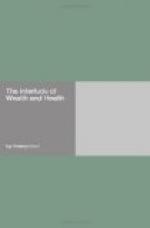To master John wally these bokes Called Welth and helthe/the treatise of the ffrere and the boye / stans puer ad mensam another of youghte charyte and humylyte an a b c for cheldren in englesshe with syllabes also a boke called an hundreth mery tayles ij^s [Arber’s Transcript, I. 75.]
That Waley printed an edition is therefore to be presumed, but it does not necessarily follow that the extant copy, which though perfect bears neither date nor printer’s name, ever belonged to it. Indeed, a comparison with a number of works to which he did affix his name suggests grave doubts on the subject. Though not a high-class printer, there seems no reason to ascribe to him a piece of work which for badness alike of composition and press-work appears to be unique among the dramatic productions of the sixteenth century.
‘Wealth and health’ appears among the titles in the list of plays appended to the edition of Goffe’s Careless Shepherdess, printed for Rogers and Ley in 1656. The entry was repeated with the designation ‘C[omedy].’ in Archer’s list of the same year, and, without the addition, in those of Kirkman in 1661 and 1671. In 1691 Langbaine wrote ‘Wealth and Health, a Play of which I can give no Account.’ Gildon has no further information to offer, nor have any of his immediate followers. Chetwood, in 1752, classes it among ’Plays Wrote by Anonymous Authors in the 16th [by which he means the seventeenth] Century,’ calls it ‘an Interlude’ and dates it 1602. This invention was only copied in those lists which depended directly on Chetwood’s, such as the Playhouse Pocket-Companion of 1779. Meanwhile, in his Companion to the Play-House of 1764, D.E. Baker, relying upon Coxeter’s notes, gave an essentially accurate description of the piece, except that he asserted it to be ‘full of Sport and mery Pastyme,’ and described it as an octavo. This entry has been copied by subsequent bibliographers, none of whom have seen the original.
The play was among those discovered in Ireland in the spring of 1906 and sold at Sotheby’s on 30 June, when it was purchased for the British Museum at the price of one hundred and ninety-five pounds. Its press-mark is C. 34. i. 25.
The extremely careless typography of the original makes the task of reprinting a difficult one. Ordinary misprints abound, and these have been scrupulously retained, a list of irregularities being added below. It has, however, proved impossible to arrive at any satisfactory method of distinguishing between ‘n’ and ‘u.’ In the first hundred lines, which are by no means the worst printed, there are thirty-two cases in which the letter is indistinguishable, eighteen cases of an apparent ‘u’ which should be ‘n,’ and seven cases of an apparent ‘n’ which should be ‘u.’ When it is further remembered that there are few cases in which it is possible to say for certain that a letter really is what it appears to be, and none in




